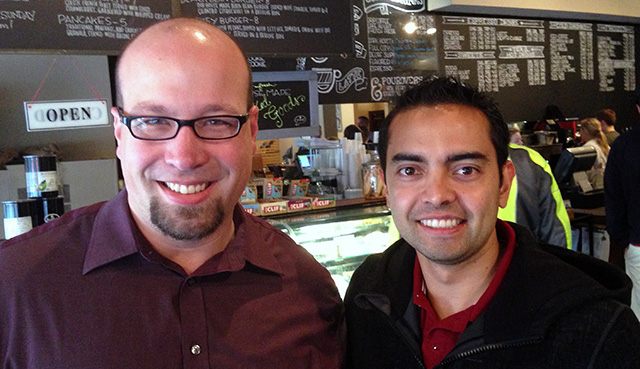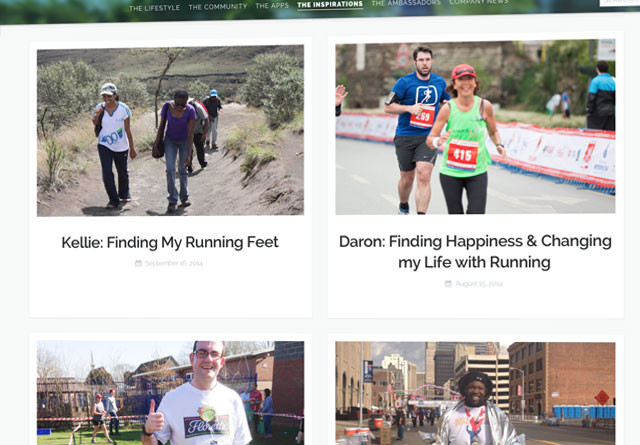
In last week’s article, we talked about the three basic steps that a startup can take in order to gain traction: get people to notice you, get those people to become customers, and keep those customers. This week we’ll dive into the last of those three, “keep those customers.” We’ll also look at what it means to turn customers not only into brand loyalists, but also advocates for your product.
We see brand loyalty all around us. Ask me if you think a membership to Costco is worth it and you will see my face light up.

As a father of 4 children, I know the value of buying in bulk, and Costco allows me to do that at consistently low prices. That would be enough to turn me into at least a satisfied customer, but what does Costco do that goes the extra mile to turn me into a fan? Why do I feel that shopping at Costco is a family outing that we all get excited for? There are a few considerations that Costco has made in order accommodate our family of 6:
- The parking lot has “painted in” extra space between vehicles, making entry and exit easy, as well as navigating a cart between aisles.
- The shopping carts have room for two children to sit, corralling the littlest ones during our shopping trip.
- The aisles are the widest I’ve ever seen, giving plenty of room and removing that feeling that my kids are in someone else’s way.
- There are many free samples, How do I know if my kids are going to like chicken and vegetable potstickers? The samples of course! There are usually no fewer than 10 different sample stations set up at any given time, allowing us to try new things and see how the kids will react before buying a 2-week supply.
- They have a tasty, affordable food court. After shopping we can enjoy a huge slice of cheese pizza for under $2. We actually split this pizza slice three ways when feeding the kids.
All of these little details are what has turned me into a brand loyalist, because shopping at Costco is not just some errand I have to run, but it is an experience.
Have you ever heard someone rave about the peanuts they’ve received while on a flight? Probably not.

Even though the peanuts are a “nice extra”, they are not really that nice, at least not nice enough to wow me in any way. In fact, they are sort of expected. I strangely feel as if it is my right to enjoy free honey-roasted nuggets whenever my stomach rises to 30,000 feet.
How do wow our customers in a way that rises above the small tokens that everybody else is doing (like handing out pens at a conference), and makes an impression? How can we make them excited to be a customer, so much that they tell others about it?
First we must recognize that customers typically follow through four stages in sequence from purchase to advocacy:
- Purchase
- Satisfaction
- Loyalty
- Advocacy
There are actions we can take in each of these stages in order to increase the likelihood that they’ll enter into the next one, and finally reward those who reach advocacy so they continue to spread the word.
The Purchase Phase
When people make a purchase, they are telling you with their wallets that they are trusting in your product. In many cases, at least on a subconscious level, they have doubts and fears during this process. What we need to focus on at this point is making the purchase process as frictionless as possible.
Throughout the purchase process, it should be clear how much they are being charged, whether or not it will recur, and if so, how. They should know exactly what they are getting, and it wouldn’t hurt to put a testimonial or two in the checkout process to help ease their doubts.
Once someone has made a purchase, many mediocre businesses sit back and just enjoy the profit. However, a company that wants to send customers through the sequence towards advocacy starts their most important work at this time.
Implement MEMs
At a company I used to work for, our co-founder was always striving to inject “MEMs” into our product, that is, “Memorable Engaging Moments.” Essentially, we were trying to create situations where a customer does X, expects Y, but receives Y, Z, and a few other extras. This works in any type of business, not just software.
When I had a flat tire that needed fixed, I ran it into the auto mechanic near my office. They not only fixed the tire, but they had a pretty clean office and the technician I spoke with was a pretty pleasant fellow. I thought to myself, “I might come back here again in the future”. I then asked how much an oil change would cost. Knowing that I was not a regular customer, the technician said, “For you, nothing. Bring this card in for a free oil change next time you need one. Thanks for trusting us with your business today.”
Not only did I come back to that establishment for my oil change a few weeks later, but I continued using them for projects large and small ever since. I’ve even recommended them to a few friends in town looking for a mechanic. I became their advocate.
In what way can you do something unexpected whenever someone purchases your product? People are getting used to transactional emails, “thanking you” for your purchase. What if you actually sent them a short video clip of someone on your customer success team (or yourself if you are a solopreneur) thanking them by name, and giving them your email if they have any questions or concerns?
A few months ago I made a purchase from Death the the Stock Photo, a company that sends free, high-quality photos for commercial use via email (as well as a SaaS component to access the archives and exclusives). What happened a few days after that purchase amazed me. Not only did I receive some high-quality photos, but one of those photos was turned into a postcard and sent to me with a handwritten note.

You might be thinking to yourself, “That doesn’t scale”. Who says everything has to scale? Things that don’t scale can make a big impact, and are often worth the time or manpower needed to execute them if they lead to an ever-growing user-base.
The Satisfaction Phase
So, you’ve wowed them during the purchase phase (or immediately afterward). Now it’s time to ensure that they are satisfied with your product. I once heard someone say “Successful customers don’t churn.” Churn means leaving your recurring product, or returning your one-time purchase.
It is surprising how many companies take credit cards on a recurring basis from people and yet don’t reach out to make sure that the customer is experiencing success with the product. There are tools out there like Customer.io and Intercom that send a series of emails automatically based off of what a customer does or doesn’t do. You could use these tools to reach out to people that have signed up for your product, but haven’t yet filled out their profiles, or taken key actions within your application after a certain period of time. Perhaps you can send out a quick “how-to” video and explain the benefits of using a certain key feature of your application.
Just because they are already your customer (i.e. you have their money) doesn’t mean that they are a satisfied customer.
The Loyalty Phase
One of my favorite tactics that I’ve seen companies use is to send out a handwritten postcard with some stickers or a t-shirt after you’ve been using their products for a certain period of time. One company that has done this to me recently is Beanstalk, a service to host and distribute (deploy) code for programmers. After three months of being a paying customer, they emailed me and asked if I could provide my shipping address, they had something to send my way. A few days later I received a handwritten note from someone on the team with stickers. After a year with them, I received a t-shirt in the mail with another thank-you note.
They’ve made me feel like a valuable part of their community, not just another account number. This has in turn made me a loyal customer of theirs, and I continue to recommend their services to others.
How can you go the extra mile to reward loyalty? Retail stores do this all of the time with customer appreciation coupons, rewarding people for repeat purchases with exclusive coupons and discounts. Some companies even have parties where they entertain their most loyal customers.
Don’t take your loyal customers for granted, devise some methods for showing them that you appreciate their loyalty. A loyal customer is only one step away from being an advocate.
The Advocacy Phase
If you have an awesome product, people WILL begin advocating for you. At this point, your best move is to find ways to show them appreciation for the advocacy. One of the people I know who does it the best is Pat Flynn, from The Smart Passive Income Blog. Pat has a variety of products, some free, some paid. What I have noticed from Pat is that when you send him an email, he answers (or his assistant answers, which he is up-front about). When you tweet out a positive note about him, he usually engages with a reply, retweet, or favorite. I recently mentioned Pat in a previous article and he took the time to leave a reply at the end of the post.
Now, I know Pat is just one guy, and there comes a point where this won’t scale. However, Pat currently has a Twitter following of over 100,000 people, and his products brought in over $98,000 last month alone! Whenever I talk with someone about Pat, the response is the same. People love this guy.

Pat and Myself at a coffee-shop meetup
If Pat can find the time to personally engage this much with his fans (or advocates), then it should be doable for another entrepreneur with a smaller following to try to follow suit. This should certainly be possible for a company with a team to have a person whose job it is to monitor social media and blog posts to engage with those advocates that are out there.
Highlight Your Happy Customers
I don’t have exact numbers on this, but I’m willing to bet that people who receive public recognition for being a happy customer are more likely to share their experiences with others. Essentially, by recognizing them you give them the role of brand advocate by default.
Grasshopper celebrates its happy customers by sharing their stories on a page in their marketing site. This not only makes Grasshopper look good, but provides a little attention towards the small businesses that really value the mention and link.

Using testimonials is another great way to identify and promote your brand advocates. Whenever someone sends me a kind word via email that might be worked into a testimonial, I ask if they mind if I do so. I then publish a few of these throughout my site.
You can also highlight your customers whenever they mention you on social media. It seems a little vain at first, but retweeting something positive that your customers are saying about you might be the little push that a potential customer who isn’t yet on a paid plan might need to make that purchase. Also, it lets the one who sent out the tweet know that you appreciate it by sharing their name with your audience.
A few podcasts that I listen to read their iTunes reviews before each show, which is a great way to encourage more people to leave reviews, in hopes of being mentioned “on the air.” It also reminds everyone that each positive word is received by the team, and appreciated.
Finally, highlighting your customers on your blog is a great way to show them your appreciation. Runkeeper keeps a blog with inspirational stories of people who have found success by using their product.

Highlighting these customer success stories not only show appreciation for those who have used your product in a meaningful way, but also encourages others to get the most out of it in hopes of one day being featured themselves!
Conclusion
Nothing does a better job promoting your brand than fanatical customers. We’re more likely to buy from someone that we know or trust who enjoys a product than just believing the company themselves behind the product. Customers who make a purchase must first be satisfied with their purchase, then they become loyal customers, and hopefully turn into brand advocates.